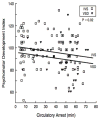Brain in Congenital Heart Disease Across the Lifespan: The Cumulative Burden of Injury
- PMID: 27185022
- PMCID: PMC5519142
- DOI: 10.1161/CIRCULATIONAHA.115.019881
Brain in Congenital Heart Disease Across the Lifespan: The Cumulative Burden of Injury
Abstract
The number of patients surviving with congenital heart disease (CHD) has soared over the last 3 decades. Adults constitute the fastest-growing segment of the CHD population, now outnumbering children. Research to date on the heart-brain intersection in this population has been focused largely on neurodevelopmental outcomes in childhood and adolescence. Mutations in genes that are highly expressed in heart and brain may cause cerebral dysgenesis. Together with altered cerebral perfusion in utero, these factors are associated with abnormalities of brain structure and brain immaturity in a significant portion of neonates with critical CHD even before they undergo cardiac surgery. In infancy and childhood, the brain may be affected by risk factors related to heart disease itself or to its interventional treatments. As children with CHD become adults, they increasingly develop heart failure, atrial fibrillation, hypertension, diabetes mellitus, and coronary disease. These acquired cardiovascular comorbidities can be expected to have effects similar to those in the general population on cerebral blood flow, brain volumes, and dementia. In both children and adults, cardiovascular disease may have adverse effects on achievement, executive function, memory, language, social interactions, and quality of life. Against the backdrop of shifting demographics, risk factors for brain injury in the CHD population are cumulative and synergistic. As neurodevelopmental sequelae in children with CHD evolve to cognitive decline or dementia during adulthood, a growing population of CHD can be expected to require support services. We highlight evidence gaps and future research directions.
Keywords: congenital abnormalities; heart diseases.
© 2016 American Heart Association, Inc.
Conflict of interest statement
Figures






References
-
- Marelli AJ, Ionescu-Ittu R, Mackie AS, Guo L, Dendukuri N, Kaouache M. Lifetime Prevalence of Congenital Heart Disease in the General Population from 2000 to 2010. Circulation. 2014;130:749–756. - PubMed
-
- Afilalo J, Therrien J, Pilote L, Ionescu-Ittu R, Martucci G, Marelli AJ. Geriatric congenital heart disease burden of disease and predictors of mortality. J Am Coll Cardiol. 2011;58:1509–1515. - PubMed
-
- Mazor Dray E, Marelli AJ. Adult Congenital Heart Disease: Scope of the Problem. Cardiol Clin. 2015;33:503–512. - PubMed
-
- Wernovsky G. Current insights regarding neurological and developmental abnormalities in children and young adults with complex congenital cardiac disease. Cardiol Young. 2006;16(Suppl 1):92–104. - PubMed
Publication types
MeSH terms
Grants and funding
LinkOut - more resources
Full Text Sources
Other Literature Sources
Medical
Research Materials

